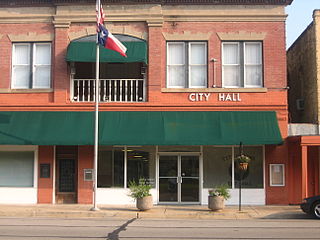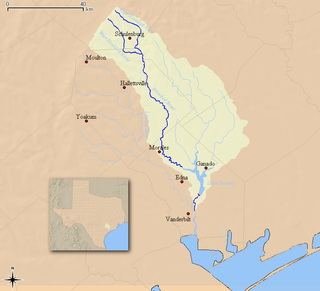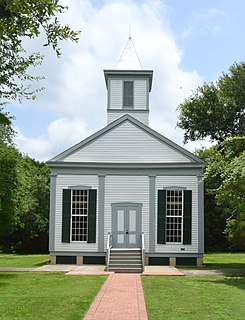
Lavaca County is a county located in the U.S. state of Texas. As of the 2010 census, its population was 19,263. Its county seat is Hallettsville. The county was created in 1846. It is named for the Lavaca River which curves its way South East through Moulton and Hallettsville before reaching the coast at Matagorda Bay.

Calhoun County is a county located in the U.S. state of Texas. As of the 2020 census, the population was 20,106. Its county seat is Port Lavaca. The county is named for John Caldwell Calhoun, the seventh vice president of the United States. Calhoun County comprises the Port Lavaca, TX Micropolitan Statistical Area, which is also included in the Victoria-Port Lavaca, TX Combined Statistical Area.

Port Lavaca is a city in Calhoun County, located in the U.S. state of Texas. The population was 12,248 at the 2010 census. It is the county seat of Calhoun County and part of the Victoria, Texas Metropolitan Statistical Area. Port Lavaca is 130 miles (210 km) southwest of Houston.

Edna is a city in Jackson County, Texas, United States. The population was 5,499 at the 2010 census. Edna is the county seat.

Lavaca Bay is a northwestern extension of the Matagorda Bay system found mostly in Calhoun County, Texas, United States. The ports of Port Lavaca and Point Comfort have been established on the bay, and are the main areas of human habitation. Linnville was located on the bay until its abandonment after the Great Raid of 1840, and the major port of Indianola was found near the confluence with the main Matagorda Bay, until the town's final destruction following the massive hurricane of 1886. Smaller communities include Olivia, Alamo Beach and Magnolia Beach. Lavaca Bay is approximately 82 miles (130 km) northeast of Corpus Christi, about 121 miles (190 km) southwest of Houston, and 145 miles (230 km) southeast of San Antonio.

Matagorda Bay is a large Gulf of Mexico bay on the Texas coast, lying in Calhoun and Matagorda counties and located approximately 80 miles (130 km) northeast of Corpus Christi, 143 miles (230 km) east-southeast of San Antonio, 108 miles (174 km) south-southwest of Houston, and 167 miles (269 km) south-southeast of Austin. It is one of seven major estuaries along the Gulf Coast of Texas and serves as the mouth of numerous streams, most notably the Lavaca and Colorado Rivers. The Texas seaport of Port Lavaca is located on the system's northwestern extension of Lavaca Bay. The city of Palacios is found on northeastern extension of Tres Palacios Bay, and Port O'Connor is located on the southwestern tip of the main bay's shore. The ghost town of Indianola, which was a major port before it was destroyed by two hurricanes in the late 19th century, is also found on the bay.

The Lavaca River is a navigable river in the U.S. state of Texas. It begins in the northeastern part of Gonzales County, and travels generally southeast for 115 miles (185 km) until it empties into Lavaca Bay, which is a component of Matagorda Bay.

The Navidad River is a 90-mile (140 km)-long coastal river in the U.S. state of Texas that runs roughly parallel to its sister river, the Lavaca River. It is not spring fed, and all of its volume is runoff, which eventually provides for much of the water in Lake Texana.

Lake Texana is a reservoir on the Navidad River, 8 miles (13 km) east of Edna, in Jackson County, Texas. The reservoir is formed by the construction of Palmetto Bend Dam. The dam and lake are managed by the Lavaca-Navidad River Authority, and supply water to surrounding communities and industries. Lake Texana is the only reservoir managed by the Authority.
Calhoun County Independent School District is a public school district based in Port Lavaca, Texas (USA).

Brackenridge Recreation Complex is a park operated by the Lavaca-Navidad River Authority. The park is a former state park in Texas then known as Lake Texana State Park and is located near Edna in Jackson County, halfway between Houston and Corpus Christi on Lake Texana.

Texana, Texas is a ghost town which was located in Jackson County near Edna. The community was one of the earliest Anglo-American settlements in the state. The town flourished as late as 1880, but when the railroad bypassed the town, it rapidly declined. The site now lies under the Lake Texana reservoir.
The DeWitt Colony was a settlement in Mexico founded by Green DeWitt. From lands belonging to that colony, the present Texas counties of DeWitt, Guadalupe and Lavaca were created. The hub of the colony was primarily located, however, in what is now Gonzales County. The first battle of the Texas Revolution occurred in the DeWitt Colony.
The Wild Man of the Navidad is believed to be one of the first sightings of Bigfoot in Texas.

Texana Presbyterian Church is a historic church in Brackenridge Recreation Complex outside of Edna, Texas.

Speaks is an unincorporated area in southeast Lavaca County in the U.S. state of Texas. It is located on Farm to Market Road 530 (FM 530) southeast of the county seat at Hallettsville. In 1866 the settlement was known as Speaksville. Ten years later the name was changed to Boxville. The name was altered to Speaks when a post office opened in 1928. Since 1950 the community's population has hovered between 50 and 60.

The U.S. state of Texas has a series of estuaries along its coast on the Gulf of Mexico, most of them bounded by the Texas barrier islands. Estuaries are coastal bodies of water in which freshwater from rivers mixes with saltwater from the sea. Twenty-one drainage basins terminate along the Texas coastline, forming a chain of seven major and five minor estuaries: listed from southwest to northeast, these are the Rio Grande Estuary, Laguna Madre, the Nueces Estuary, the Mission–Aransas Estuary, the Guadalupe Estuary, the Colorado–Lavaca Estuary, East Matagorda Bay, the San Bernard River and Cedar Lakes Estuary, the Brazos River Estuary, Christmas Bay, the Trinity–San Jacinto Estuary, and the Sabine–Neches Estuary. Each estuary is named for its one or two chief contributing rivers, excepting Laguna Madre, East Matagorda Bay, and Christmas Bay, which have no major river sources. The estuaries are also sometimes referred to by the names of their respective primary or central water bodies, though each also includes smaller secondary bays, inlets, or other marginal water bodies.












